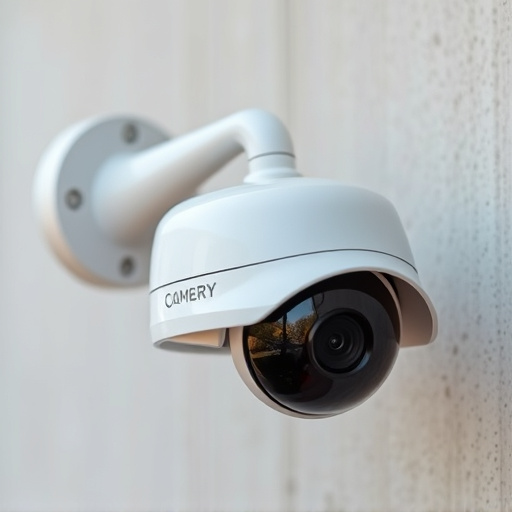Dummy security cameras placed at optimal heights (5–7 feet outdoors, 6–8 feet indoors) act as effective deterrents against theft and vandalism by mimicking real surveillance equipment. Strategically positioning them at eye level or slightly elevated conveys a strong message of non-tolerance for unauthorized activities, triggering thieves' instinct to avoid detection and making them less likely to target secure areas. This psychological effect, combined with their visible yet non-obtrusive placement, creates a sense of constant surveillance, protecting retail stores, businesses, and residential properties from security threats.
In today’s world, securing valuable assets is paramount, and dummy security cameras offer a creative solution to deter theft. This article explores the power of decoy cameras as a visual deterrent, providing insights into how they can protect against criminal activities. We’ll delve into the science behind their effectiveness, offering a comprehensive guide on choosing the ideal placement based on industry-standard dummy security camera height guidelines. Discover successful use cases across various sectors and unlock the potential of these innovative safety measures.
- Understanding Dummy Security Cameras and Their Role in Deterring Theft
- The Science Behind Visual Deterrence: How Decoy Cameras Impact Thieves
- Choosing the Right Placement: Factors to Consider for Optimal Dummy Camera Positioning
- Effective Use Cases: Industries Benefiting from Dummy Security Cameras
Understanding Dummy Security Cameras and Their Role in Deterring Theft
Dummy security cameras, also known as decoy or mock cameras, are a strategic deterrent against theft and vandalism. They mimic the appearance of real surveillance equipment but lack the advanced functionality. These decoys are an affordable and effective way to reinforce security measures, especially in retail stores, businesses, and residential areas. The key lies in their realistic design and strategic placement, which can significantly impact potential thieves’ behavior.
When installing dummy security cameras, it’s essential to consider the height guidelines for optimal effectiveness. Typically, placing them at eye level or slightly elevated is recommended. This positioning ensures a clear view of the area while deterring criminals from targeting vulnerable spots. By adhering to these simple installation tips, business owners and homeowners can create an illusion of heightened surveillance, potentially discouraging theft-related activities.
The Science Behind Visual Deterrence: How Decoy Cameras Impact Thieves
The Science Behind Visual Deterrence: How Decoy Cameras Impact Thieves
Dummy security cameras, strategically placed at various heights, serve as a powerful psychological tool in deterring potential thieves. The concept is rooted in the idea of visual deterrence—the use of surveillance equipment to convey a strong message that unauthorized activities will not be tolerated. When a thief encounters what appears to be an active camera system, even if it’s a decoy, their instincts are triggered to avoid detection and potential consequences.
The dummy security camera height guidelines suggest placement at eye level or slightly elevated, mimicking real surveillance equipment. This positioning creates the illusion of constant observation, making thieves more cautious and less likely to attempt theft. The psychological impact is significant, as it disrupts the sense of anonymity often sought by criminals, effectively deterring them from targeting secure areas.
Choosing the Right Placement: Factors to Consider for Optimal Dummy Camera Positioning
When placing decoy cameras, or dummy security cameras, as a deterrent for theft, strategic positioning is key. Consider the following factors to ensure optimal effectiveness:
First and foremost, height is crucial. Dummy cameras should be installed at a realistic eye-level—typically around 5–7 feet (1.5–2.1 meters) above the ground. This mimics the typical placement of real security cameras, making it less obvious when a decoy is used. Lower positioning may go unnoticed, while cameras mounted too high can be easily spotted, defeating the purpose.
Additionally, visibility and line of sight are essential considerations. Place the dummy cameras in open areas where potential thieves can clearly see them. Positioning them near entry points, such as doors or windows, sends a powerful message that your property is under surveillance. The camera’s view should cover key areas, providing a comprehensive deterrent effect.
Effective Use Cases: Industries Benefiting from Dummy Security Cameras
Dummy security cameras, also known as decoy or mock surveillance devices, have proven to be effective deterrents against theft and other security threats across various industries. Their strategic placement can significantly reduce the risk of criminal activity by giving would-be perpetrators the impression that they are under constant observation. This psychological effect is particularly valuable in high-theft areas such as retail stores, jewelry shops, and convenience stores, where the cost of merchandise makes theft a significant concern.
The effectiveness of dummy security cameras can be maximized by adhering to specific height guidelines. Generally, these cameras should be placed at a height that is visible but not overly obtrusive. For outdoor areas, a height of 5-7 feet (1.5-2.1 meters) above ground level is recommended, while for indoor spaces, they should be positioned around 6-8 feet (1.8-2.4 meters) off the floor. This positioning ensures that the cameras are conspicuous enough to deter potential thieves without drawing unnecessary attention or causing obstruction. Industries benefiting from this technology include not only retail but also warehouses, banks, and even residential communities looking to enhance their security measures.
Dummy security cameras, strategically placed according to the optimal height guidelines, offer a cost-effective and convincing decoy solution for deterring theft. By leveraging the psychological impact of visual surveillance, these cameras can significantly reduce crime rates across various industries. When properly utilized, they serve as a powerful tool in enhancing overall security measures, acting as both a physical deterrent and a silent guardian against unauthorized activities.
